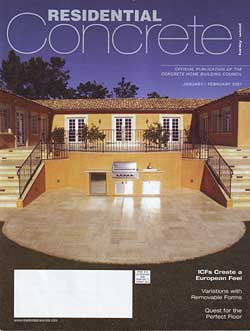 |
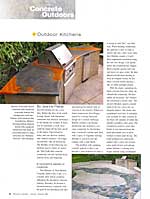 |
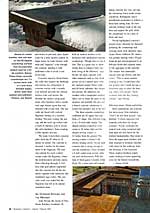 |
Outdoor Kitchens
by Jeanne Fields
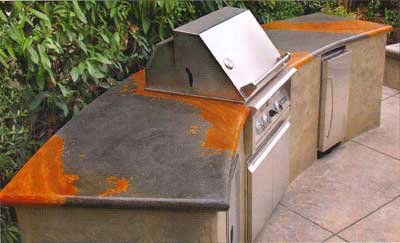
Above: Concrete block overlaid with textured concrete house the refrigerator and barbeque, and support the countertop. Below: Incorporating natural stone into projects enhances the look of concrete and is a key direction for Ralston. 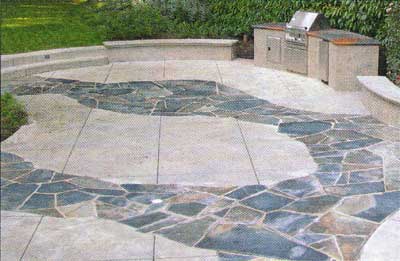
Photos: Tom Ralston
Second kitchens are not a new idea. Before the days of air conditioning, homes with basements sometimes had kitchens downstairs to use during hot weather. If there was no basement, a cook stove could be found off the back porch of the house. Fast-forward to today and you discover fashionable outdoor kitchens-no longer second best-but all dressed up. The builders of the following two kitchens used a variety of materials. They both have concrete countertops but also include brick, Lannon stone, and flagstone.
A COUNTERTOP INSPIRED BY FLAGSTONE
Tom Ralston, of Tom Ralston Concrete, Santa Cruz, Calif., is a concrete artist whose creativity influences the decorative concrete industry. Recently, he became a licensed masonry cQntractor with the goal of incorporating rock and maximizing the natural look of concrete in his projects. When Los Gatos homeowner John Hogan asked for a unique backyard design for a kitchen barbeque, Ralston created a curvilinear installation that included a concrete countertop for the kitchen area, a textured concrete pool deck with a spray of flagstone running through it, and pool and spa copings with a sand finish.
"The problem, with stamping concrete patterns is that it can become a poor imitation of what it is trying to look like," says Ralston. When building countertops the question is how to make it artistic and not a mere stone imitation. Ralston created a 2-inch thick engineered countertop, using his own mix design. Cast upside down, the countertop has integral black concrete against each end and leaves an open center. He then placed polyethylene sheeting to form an irregular border for the black concrete before placing a mix of white Portland cement.
With the plastic separating the black concrete from the white, he vibrated the countertop. He then pulled up the plastic and vibrated the countertop a second time. The second vibration caused a natural meld of the two colors into an irregular pattern. The plastic also contributed vein lines. A serendipitous accident of white concrete in the black left splashes of white like smaller crystalline color areas. The countertop cured for seven days before it was removed from the mold and turned over to allow workers to hand sand the top. The white Portland was chemically stained with a color mix of terTa cotta, padre brown, and antique amber. Ralston's coloring techniques include using eyedroppers and straws to precisely place liquid color for a truly random pattern.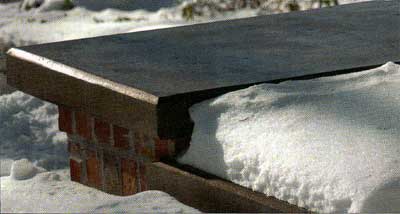
Above: In cooler months, one can lean on the 85-degree countertop surface that incorporates radiant heat for a little comfort. Below: These three concrete countertops are 11/2 inches thick with 31/2-inch-thick beveled edges, which were then stained and polished.
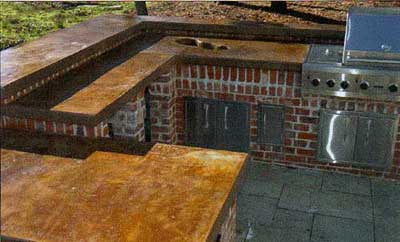
Photos: Joe Nasvik
In larger areas, he loads brushes with stain and "trapezes" color through the concrete, melding it with additional color to avoid a contrived look.
Concrete masonry block forms the walls that support the barbeque and enclose the refrigerator. A concrete overlay with a scratch coat beneath provides the vertical surface color and texture. He finished the surface using sandstone color hardener with a weathered sage release agent that was textured with a slate skin. The spa walls are faced with vertical flagstone resting on a concrete footing. The pool coping, the spa cap, and the wall cap surface had a wash of muriatic acid to reveal the color hardener's fines creating a little sparkle and grit.
The main 4-inch-thick concrete patio deck has #3 rebar at 18 inches on center. The concrete is recessed 2 inches for the placement of the flagstone. The slab was jointed for crack control except under the flagstone, where the reinforcement prevents cracks from reflecting through, A 5x5foot slate grid pattern imprinted into the concrete ties all the elements together with sandstone and weathered sage colors. The concrete work was sealed but the flagstone was left in its natural weathered state.
AN OUTDOOR KITCHEN FOR THE MIDWEST
John Novak, the owner of Fine Home Builders, Lombard, Ill., built an outdoor kitchen in his backyard with multitiered concrete countertops. "People have to see it first. This is a great way to show clients how to enhance their outdoor living in the Midwest," says Novak. He pairs concrete with other materials such as clay brick pavers set in a sunken patio with dry stacked Lannon Stone walls and all-brick cabinetry that frames the kitchen. He addresses the weather with a suspended outdoor fabric sail to shade the patio in the summer, and portable fire pits and a heated concrete countertop to extend the kitchen's use in the fall.
The three concrete countertops combined are 92 square feet and form a U shape. One 4x8-foot wing is at a 30-inch table height. The shaped kitchen countertop work center is 36 inches high and the shaped serving counter is 42 inches from the ground. The serving counter is heated with electric heating cables. Novak used concrete that is strong enough to cast the countertop, which includes a 6-inch cantilevered. section, without steel reinforcement. With the help of Burlingame Concrete, Glen Ellyn, Ill., a threepart self-consolidating concrete mix was cast into the countertop forms under winter conditions. Burlingame used a nonchloride accelerator to achieve a three-hour setting time. Six-foot concrete footings reach to the clay base and support the grill, while the countertops sit on a base of brick and steel.
Novak highlighted concrete's natural stone character by diamond polishing the countertops and coloring them with chemical stain. Amici Stone, Addison, Ill., used a wet grinder starting with a 50-grit diamond pad and progressed to an 800-grit finish that exposed some of the aggregate in the concrete. The surface was chemically stained with tan, brown, and rust colors. "This is more creative looking to me. I could have chosen granite, but I could not use a thickened edge or place the heating cables with granite. These counters look like they belong outside," says Novak.
MOVING AWAY FROM IMITATION
Both installations use concrete but move away from imitation. "Now I do not limit myself," says Ralston, "I chose materials that naturally articulate the design concept." Novak continued the natural look using oversized tumbled dark red clay brick for the kitchen backsplashes, blue stone to floor the upper patio kitchen, and then returned to textured concrete with skins for the walkway from the driveway to the backyard. These outdoor kitchens might make cooking at home appealing even for the busiest households.
